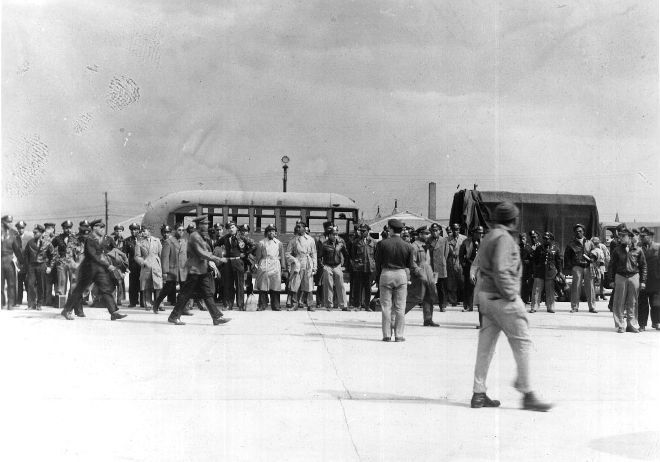By Brother David L. Carl
1-93-G

Arrested African-American officers of the 477th Bombardment Group at Freeman Field, Indiana, await transport, April 1945.
When World War II erupted, George Silva Lima, Jr. courageously served as a lieutenant with the Tuskegee Airmen. As part of America’s first Black military pilots, he dispelled the falsehood that Black men lacked the intelligence, skill, and patriotism to fly. The son of Cape Verdean immigrants, he fought not only the foreign enemy; Lima and his fellow airmen battled their own military authorities to break the color barrier and win the right to stand as men.
In April 1945, as a member of the U.S. Army’s 477th Bombardment Group, Lima helped lead a protest of sixty Black air corps officers against racial discrimination. Risking court martial, Lima and his fellow Black officers refused to ignore the indignation of segregation and entered the white officers’ club at Freeman Field, in Indiana.
Remembering this event Lima recounted, “When you’re a commissioned officer you get a notice from the President that you’re an officer and a gentleman. And you think that, presumably, you’re entitled to everything an officer is entitled to. And we go to the club and try to get a Coca-Cola—they tell you they can’t serve you—then you react…”
Arrested, these Black pilots and officers remained convicted in their right to dignity and respect. As a result of their bold and brave defiance of the systemic racial subjugation at Freeman Field, the army ordered the base to integrate its clubs and the commanding officer replaced.
In 1995, the Air Force officially vindicated the actions of all of these Black officers, set aside the single court-martial conviction and removed letters of reprimand from the permanent files of 15 of the officers. The mutiny is generally regarded by historians as an important step toward full integration of the armed forces and as a model for later efforts to integrate public facilities through civil disobedience. Three years later, President Truman ordered the integration of all the armed forces.